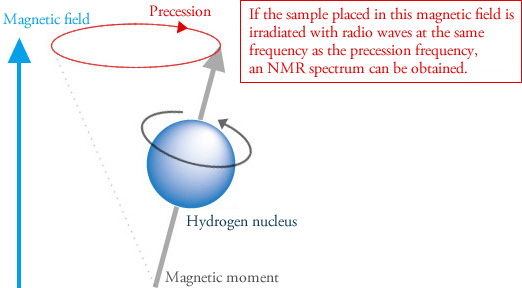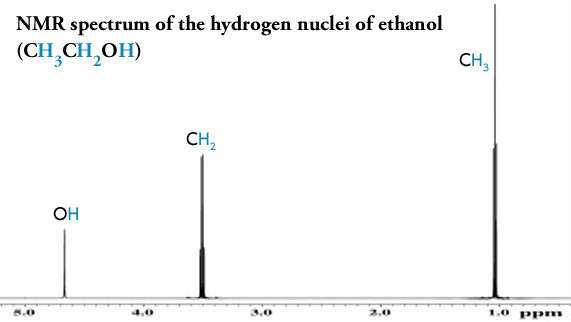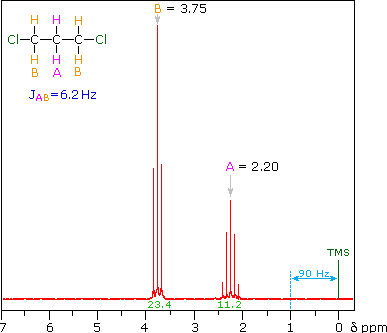Nuclear Magnetic Resonance NMR Spectroscopy is a technique used for determining the structure of organic compounds. 2 6 integral d 36 d 12 The relative area under the resonances at d 36 and 12 is 13 The integral is superimposed over the spectrum as a stair-step line.

Analytical Chemistry A Guide To 13 C Nuclear Magnetic Resonance Nmr Compound Interest
Nuclear Magnetic Resonance NMR Spectroscopy is a powerful analytical technique that can reveal structural information about many organic and inorganic molecules.

. 2 Circular radiofrequency RF wave is polarized around the origin. Welcome to the WSU Center for NMR Spectroscopy To combat the spread of COVID-19 effective September 8 2021 there is a more stringent procedure for using the NMR lab. The biomedical applications of nuclear magnetic resonance NMR are twofold.
There are two major relaxation processes. Nuclear magnetic resonance NMR spectroscopy explores the electronic environment of atoms. A powerful technique useful for identifying the small to the very large When some atoms are placed in a strong magnetic field their nuclei behave.
The WSU Center for NMR Spectroscopy is a central University facility that provides access to state-of-the-art NMR instrumentation. NMR spectroscopy utilizes the absorption of electromagnetic radiation to flip the spin state of lower energy nuclei to higher energy states by applying radio waves along the x axis. Magnetic resonance imaging MRI and magnetic resonance spectroscopy MRS.
RF is applied to the x axis. 12 based on residual quadrupolar coupling of the form of Eq. One is 12 which is anti-parallel to the magnetic field and the other is 12 which is parallel to the magnetic field.
This external energy applied to the molecule is absorbed and the perturbed nucleus is. Nuclear Magnetic Resonance Spectroscopy or NMR Spectroscopy can be used to identify any isotope unless the isotope has both an even number of protons and an even number of neutrons. Some nuclei possess a magnetic moment - such as a hydrogen nucleus 1H or a carbon nucleus 13C.
These moments are in nuclear magnetons which are 50507810-27 JT-1. The nuclei of many elements such as 13 C spin generating a magnetic field. Nuclear Magnetic Resonance Spectroscopy tutorial all along with the key concepts of Basic Principle of NMR The Source of NMR Spectra NMR spectrum Pattern of the Spectrum The.
For the four common nuclei noted above the magnetic moments are. Copyright 1997-2019 JP. 13 C Nuclear Magnetic Resonance Spectroscopy Tutorial Key Concepts.
Nuclear magnetic resonance spectroscopy is a powerful analytical technique used to characterize organic molecules by identifying carbon-hydrogen frameworks within molecules. Nuclear magnetic resonance spectroscopy tutorial. Principle of Nuclear Magnetic Resonance NMR Spectroscopy The principle behind NMR is that many nuclei have spin and all nuclei are electrically charged.
Welcome to the WSU Center for NMR Spectroscopy To combat the spread of COVID-19 effective September 8 2021 there is a more stringent procedure for using the NMR lab. The chemical environment of specific nuclei is deduced from information obtained. In NMR magnetic nuclei of specific isotopes are aligned by a strong external magnet and then perturbed by a radio wave.
1 H Nuclear Magnetic Resonance Spectroscopy Tutorial Key Concepts. This review aims at presenting in an accessible manner the requirements and limitations of this technique. Nuclear Magnetic Resonance spectroscopy is a powerful and theoretically complex analytical tool.
As an introduction the history of NMR will highlight how the method evolved from physics to chemistry and finally to biology over. Full solution of the evolution equations In this section we provide the complete solution of the evolu- tion equation Eq. The nuclei of many elements such as 1 H spin generating a magnetic field.
1H NMR is used to determine the type and number of H atoms. On this page we will cover the basic theory behind the technique. Nuclear Magnetic Resonance Spectroscopy.
The following diagram gives the approximate frequencies that correspond to the spin state energy separations for each of these nuclei in an external magnetic field of 235 T. Two common types of NMR spectroscopy are used to characterize organic structure. The applications of MRS as a research tool are extremely diverse encompassing studies on isolated cells body fluids and perfused organs at high magnetic field strengths in an experimental.
Mass spectrometry MS is an analytical technique that is used to measure the mass-to-charge ratio of ionsThe results are presented as a mass spectrum a plot of intensity as a function of the mass-to-charge ratioMass spectrometry is used in many different fields and is applied to pure samples as well as complex mixtures. The area under an NMR resonance is proportional to the number of nuclei that give rise to that resonance. NMR spectroscopy is a powerful tool for biologists interested in the structure dynamics and interactions of biological macromolecules.
Nuclear Magnetic Resonance Spectroscopy or NMR Spectroscopy can be used to identify any isotope unless the isotope has both an even number of protons and an even number of neutrons. If an external magnetic field is applied an energy transfer is possible between the base energy to a higher energy level generally a single energy gap. It is important to remember that with NMR we are performing experiments on the nuclei of atoms not the electrons.
The application of NMR spectroscopy to the study of proteins and nucleic acids has provided unique in- formation on the dynamics and chemical kinetics of these systems. Hornak is Professor of Chemistry and Imaging Science at the Rochester Institute of Technology where he teaches courses in magnetic resonance imaging nuclear magnetic resonance spectroscopy analytical chemistry and physical chemistry. The height of each step is proportional to the area under the resonance.
H0 is magnetic field which separates the energy into two. 1 H μ 27927 19 F μ 26273 31 P μ 11305 13 C μ 07022. Nuclear magnetic resonance NMR spectroscopy measurements have been firmly established among techniques used for obtaining valuable information about chemical and physical properties in a wide variety of scientific fields from biology and medicine to chemistry and physics.
E2 12 γh 2Π H0. Nuclear magnetic resonance NMR is a spec- troscopic technique that detects the energy ab- sorbed by changes in the nuclear spin state. Progress in Nuclear Magnetic Resonance Spectroscopy 79 2014 1447 23.
11 and a fluctuating quadrupolar interaction of the. 22 Magnetic Resonance. For scientists to be able to measure the exact structure of compounds to understand their properties is key.

Basic Introduction To Nmr Spectroscopy Youtube

Nmr Basic Knowledge Nuclear Magnetic Resonance Spectrometer Nmr Products Jeol

Nmr Spectroscopy In Easy Way Part 1 Youtube

Nmr Basic Knowledge Nuclear Magnetic Resonance Spectrometer Nmr Products Jeol

Analytical Chemistry A Guide To Proton Nuclear Magnetic Resonance Nmr Compound Interest


0 comments
Post a Comment